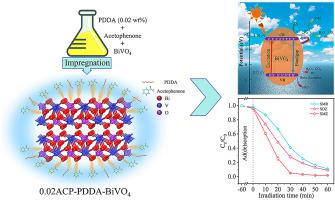Chemosphere ( IF 8.8 ) Pub Date : 2023-03-09 , DOI: 10.1016/j.chemosphere.2023.138362 Meihong Tan 1 , Wanping Shi 1 , Haifeng Wang 1 , Guanglan Di 1 , Zhengxin Xie 1 , Shisuo Fan 1 , Jun Tang 1 , Fengshou Dong 2

|
The removal of antibiotics in wastewater has attracted increasing attention. Herein, a superior photosensitized photocatalytic system was developed with acetophenone (ACP) as the guest photosensitizer, bismuth vanadate (BiVO4) as the host catalyst and poly dimethyl diallyl ammonium chloride (PDDA) as the bridging complex, and used for the removal of sulfamerazine (SMR), sulfadiazine (SDZ) and sulfamethazine (SMZ) in water under simulated visible light (λ > 420 nm). The obtained ACP-PDDA-BiVO4 nanoplates attained a removal efficiency of 88.9%–98.2% for SMR, SDZ and SMZ after 60 min reaction and achieved kinetic rate constant approximately 10, 4.7 and 13 times of BiVO4, PDDA-BiVO4 and ACP-BiVO4, respectively, for SMZ degradation. In the guest-host photocatalytic system, ACP photosensitizer was found to have a great superiority in enhancing the light absorption, promoting the surface charge separation-transfer and efficient generation of holes (h+) and superoxide radical , greatly contributing to the photoactivity. The SMZ degradation pathways were proposed based on the identified degradation intermediates, involving three main pathways of rearrangement, desulfonation and oxidation. The toxicity of intermediates was evaluated and the results demonstrated that the overall toxicity was reduced compared with parent SMZ. This catalyst maintained 92% photocatalytic oxidation performance after five cyclic experiments and displayed a co-photodegradation ability to others antibiotics (e.g., roxithromycin, ciprofloxacin et al.) in effluent water. Therefore, this work provides a facile photosensitized strategy for developing guest-host photocatalysts, which enabling the simultaneous antibiotics removal and effectively reduce the ecological risks in wastewater.
中文翻译:

光敏剂和钒酸铋之间宾主协同作用对抗生素的有效光降解:潜在机制和毒性评估
去除废水中的抗生素越来越受到人们的关注。在此,以苯乙酮(ACP)为客体光敏剂,钒酸铋(BiVO 4)为主体催化剂,聚二甲基二烯丙基氯化铵(PDDA)为桥联络合物,开发了一种优异的光敏光催化体系,用于磺胺甲基嘧啶的去除(SMR)、磺胺嘧啶 (SDZ) 和磺胺二甲嘧啶 (SMZ) 在模拟可见光(λ > 420 nm)下的水中。得到的ACP-PDDA-BiVO 4纳米片在反应60分钟后对SMR、SDZ和SMZ的去除效率达到88.9%~98.2%,动力学速率常数分别是BiVO 4、PDDA-BiVO 4和的10倍、4.7倍和13倍。ACP-BiVO 4,分别用于 SMZ 降解。在宾主光催化体系中,ACP 光敏剂被发现在增强光吸收、促进表面电荷分离转移和高效产生空穴 (h + ) 和超氧自由基方面具有很大的优势,极大地促进了光活性。基于已鉴定的降解中间体提出了SMZ降解途径,涉及重排、脱磺化和氧化三个主要途径。评估中间体的毒性,结果表明与母体 SMZ 相比,总体毒性降低。该催化剂在五次循环实验后保持了 92% 的光催化氧化性能,并显示出对流出水中其他抗生素(如罗红霉素、环丙沙星等)的共光降解能力。因此,这项工作为开发客体光催化剂提供了一种简便的光敏化策略,可以同时去除抗生素并有效降低废水中的生态风险。



























 京公网安备 11010802027423号
京公网安备 11010802027423号